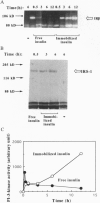Abstract
Insulin was immobilized on a surface-hydrolyzed poly(methyl methacrylate) film. Chinese hamster ovary cells overexpressing human insulin receptors were cultured on the film in the absence of serum or soluble proteins. Small amounts of immobilized insulin (1-10% of the required amount of free insulin) were sufficient to stimulate cell proliferation. In addition, the maximal mitogenic effect of immobilized insulin was greater than that of free insulin. Immobilized insulin activated the insulin receptor and downstream signaling proteins, and this activation persisted for longer periods than that obtained with free insulin, probably explaining the greater mitogenic effect of the immobilized insulin. Finally the immobilized-insulin film was usable repeatedly without marked loss of activity.
Full text
PDF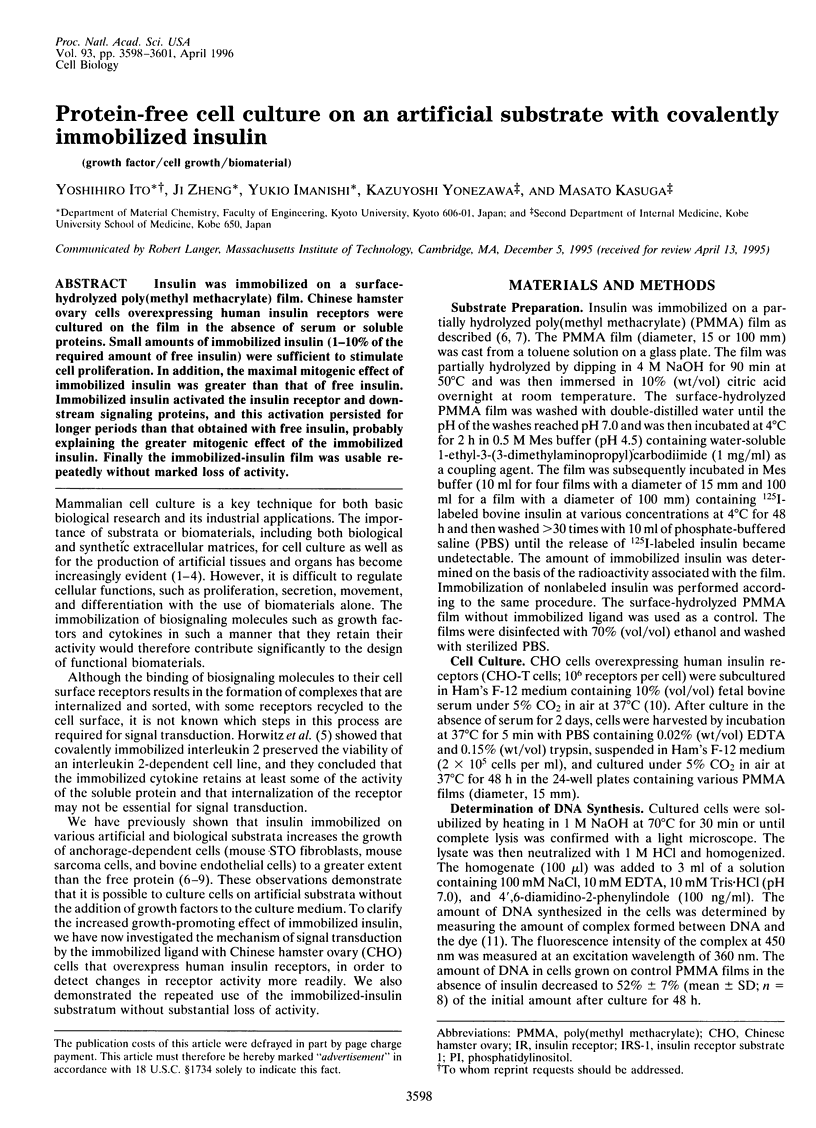
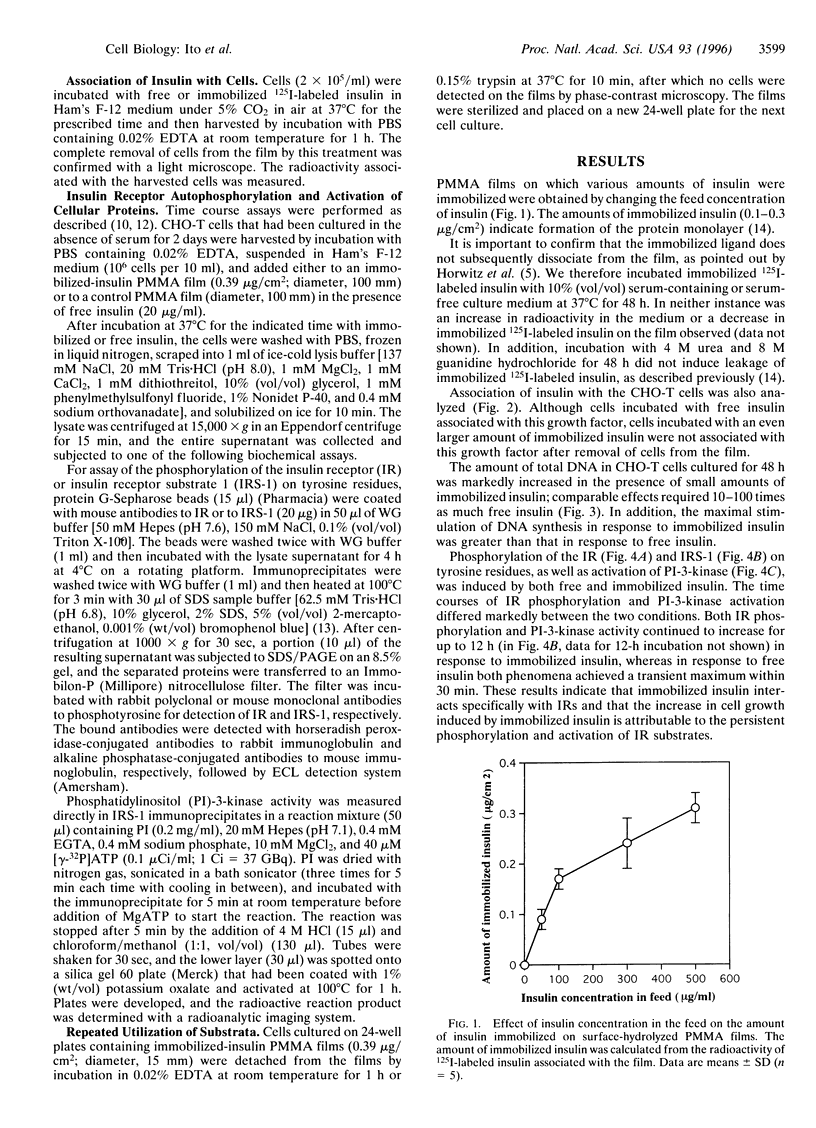
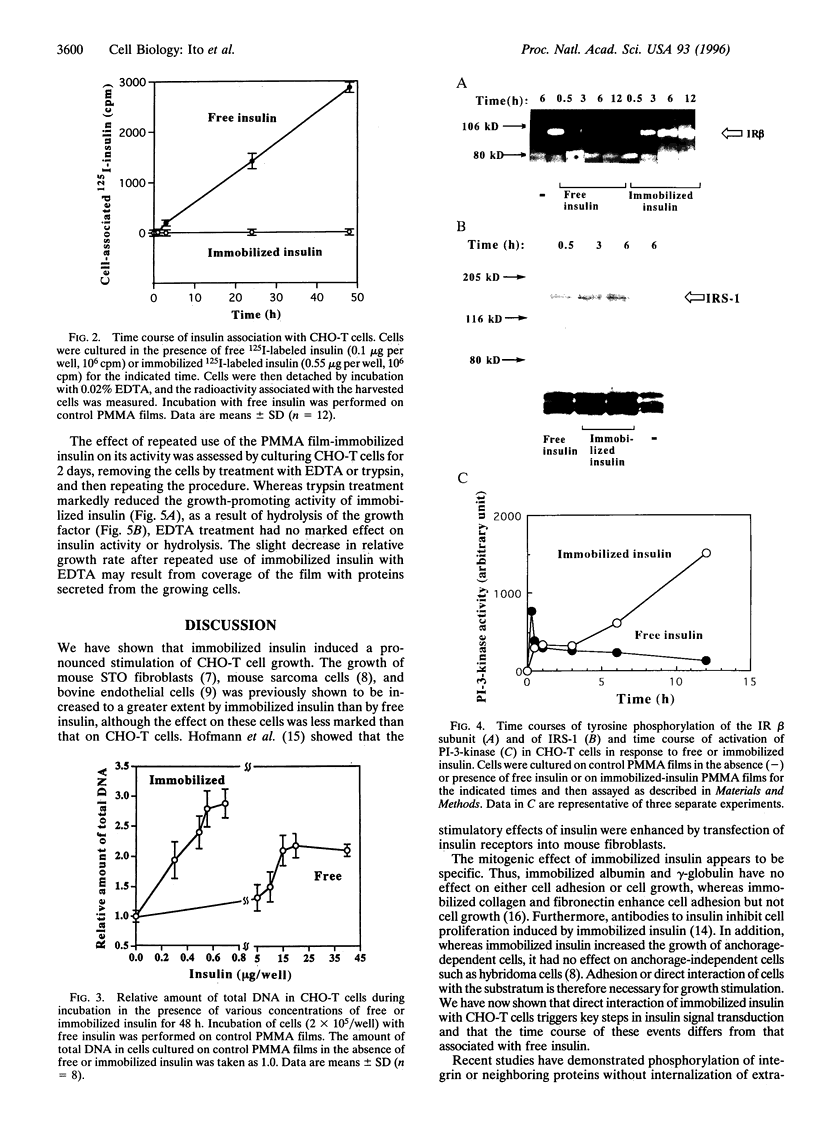
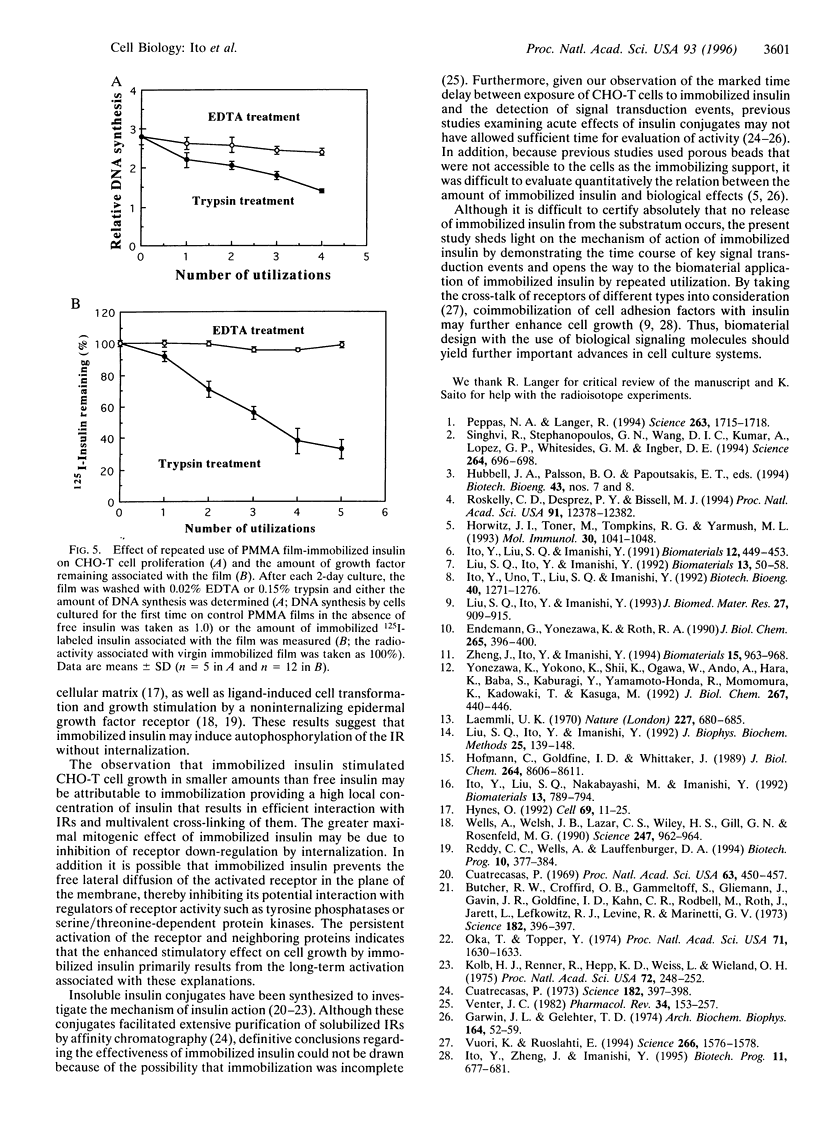
Images in this article
Selected References
These references are in PubMed. This may not be the complete list of references from this article.
- Butcher R. W., Crofford O. B., Gammeltoff S., Gliemann J., Gavin J. R., 3rd, Goldfine I. D., Kahn C. R., Rodbell M., Roth J., Jarrett L. Letter: Insulin activity: the solid matrix. Science. 1973 Oct 26;182(4110):396–398. doi: 10.1126/science.182.4110.396-a. [DOI] [PubMed] [Google Scholar]
- Cuatrecasas P. Interaction of insulin with the cell membrane: the primary action of insulin. Proc Natl Acad Sci U S A. 1969 Jun;63(2):450–457. doi: 10.1073/pnas.63.2.450. [DOI] [PMC free article] [PubMed] [Google Scholar]
- Endemann G., Yonezawa K., Roth R. A. Phosphatidylinositol kinase or an associated protein is a substrate for the insulin receptor tyrosine kinase. J Biol Chem. 1990 Jan 5;265(1):396–400. [PubMed] [Google Scholar]
- Garwin J. L., Gelehrter T. D. Induction of tyrosine aminotransferase by Sepharose-insulin. Arch Biochem Biophys. 1974 Sep;164(1):52–59. doi: 10.1016/0003-9861(74)90007-1. [DOI] [PubMed] [Google Scholar]
- Hofmann C., Goldfine I. D., Whittaker J. The metabolic and mitogenic effects of both insulin and insulin-like growth factor are enhanced by transfection of insulin receptors into NIH3T3 fibroblasts. J Biol Chem. 1989 May 25;264(15):8606–8611. [PubMed] [Google Scholar]
- Horwitz J. I., Toner M., Tompkins R. G., Yarmush M. L. Immobilized IL-2 preserves the viability of an IL-2 dependent cell line. Mol Immunol. 1993 Aug;30(11):1041–1048. doi: 10.1016/0161-5890(93)90129-y. [DOI] [PubMed] [Google Scholar]
- Hynes R. O. Integrins: versatility, modulation, and signaling in cell adhesion. Cell. 1992 Apr 3;69(1):11–25. doi: 10.1016/0092-8674(92)90115-s. [DOI] [PubMed] [Google Scholar]
- Ito Y., Liu S. Q., Imanishi Y. Enhancement of cell growth on growth factor-immobilized polymer film. Biomaterials. 1991 Jul;12(5):449–453. doi: 10.1016/0142-9612(91)90141-v. [DOI] [PubMed] [Google Scholar]
- Ito Y., Liu S. Q., Nakabayashi M., Imanishi Y. Cell growth on immobilized cell-growth factor. II. Adhesion and growth of fibroblast cells on poly(methyl methacrylate) membrane immobilized with proteins of various kinds. Biomaterials. 1992;13(11):789–794. doi: 10.1016/0142-9612(92)90019-k. [DOI] [PubMed] [Google Scholar]
- Kolb H. J., Renner R., Hepp K. D., Weiss L., Wieland O. H. Re-evaluation of Sepharose-insulin as a tool for the study of insulin action. Proc Natl Acad Sci U S A. 1975 Jan;72(1):248–252. doi: 10.1073/pnas.72.1.248. [DOI] [PMC free article] [PubMed] [Google Scholar]
- Laemmli U. K. Cleavage of structural proteins during the assembly of the head of bacteriophage T4. Nature. 1970 Aug 15;227(5259):680–685. doi: 10.1038/227680a0. [DOI] [PubMed] [Google Scholar]
- Liu S. Q., Ito Y., Imanishi Y. Cell growth on immobilized cell growth factor. 9. Covalent immobilization of insulin, transferrin, and collagen to enhance growth of bovine endothelial cells. J Biomed Mater Res. 1993 Jul;27(7):909–915. doi: 10.1002/jbm.820270710. [DOI] [PubMed] [Google Scholar]
- Liu S. Q., Ito Y., Imanishi Y. Cell growth on immobilized cell growth factor. I. Acceleration of the growth of fibroblast cells on insulin-immobilized polymer matrix in culture medium without serum. Biomaterials. 1992;13(1):50–58. doi: 10.1016/0142-9612(92)90095-6. [DOI] [PubMed] [Google Scholar]
- Liu S. Q., Ito Y., Imanishi Y. Cell growth on immobilized cell-growth factor; 4: Interaction of fibroblast cells with insulin immobilized on poly(methyl methacrylate) membrane. J Biochem Biophys Methods. 1992 Oct;25(2-3):139–148. doi: 10.1016/0165-022x(92)90006-v. [DOI] [PubMed] [Google Scholar]
- Oka T., Topper Y. J. A soluble super-active form of insulin. Proc Natl Acad Sci U S A. 1974 May;71(5):1630–1633. doi: 10.1073/pnas.71.5.1630. [DOI] [PMC free article] [PubMed] [Google Scholar]
- Peppas N. A., Langer R. New challenges in biomaterials. Science. 1994 Mar 25;263(5154):1715–1720. doi: 10.1126/science.8134835. [DOI] [PubMed] [Google Scholar]
- Reddy C. C., Wells A., Lauffenburger D. A. Proliferative response of fibroblasts expressing internalization-deficient epidermal growth factor (EGF) receptors is altered via differential EGF depletion effect. Biotechnol Prog. 1994 Jul-Aug;10(4):377–384. doi: 10.1021/bp00028a006. [DOI] [PubMed] [Google Scholar]
- Roskelley C. D., Desprez P. Y., Bissell M. J. Extracellular matrix-dependent tissue-specific gene expression in mammary epithelial cells requires both physical and biochemical signal transduction. Proc Natl Acad Sci U S A. 1994 Dec 20;91(26):12378–12382. doi: 10.1073/pnas.91.26.12378. [DOI] [PMC free article] [PubMed] [Google Scholar]
- Singhvi R., Kumar A., Lopez G. P., Stephanopoulos G. N., Wang D. I., Whitesides G. M., Ingber D. E. Engineering cell shape and function. Science. 1994 Apr 29;264(5159):696–698. doi: 10.1126/science.8171320. [DOI] [PubMed] [Google Scholar]
- Venter J. C. Immobilized and insolubilized drugs, hormones, and neurotransmitters: properties, mechanisms of action and applications. Pharmacol Rev. 1982 Jun;34(2):153–187. [PubMed] [Google Scholar]
- Vuori K., Ruoslahti E. Association of insulin receptor substrate-1 with integrins. Science. 1994 Dec 2;266(5190):1576–1578. doi: 10.1126/science.7527156. [DOI] [PubMed] [Google Scholar]
- Wells A., Welsh J. B., Lazar C. S., Wiley H. S., Gill G. N., Rosenfeld M. G. Ligand-induced transformation by a noninternalizing epidermal growth factor receptor. Science. 1990 Feb 23;247(4945):962–964. doi: 10.1126/science.2305263. [DOI] [PubMed] [Google Scholar]
- Yonezawa K., Yokono K., Shii K., Ogawa W., Ando A., Hara K., Baba S., Kaburagi Y., Yamamoto-Honda R., Momomura K. In vitro association of phosphatidylinositol 3-kinase activity with the activated insulin receptor tyrosine kinase. J Biol Chem. 1992 Jan 5;267(1):440–446. [PubMed] [Google Scholar]
- Zheng J., Ito Y., Imanishi Y. Cell growth on immobilized cell-growth factor. 10. Insulin and polyallylamine co-immobilized materials. Biomaterials. 1994 Oct;15(12):963–968. doi: 10.1016/0142-9612(94)90076-0. [DOI] [PubMed] [Google Scholar]
- Zheng J., Ito Y., Imanishi Y. Growth enhancement of anchorage-dependent and anchorage-independent cells by coimmobilization of insulin with poly(allylamine) or gelatin. Biotechnol Prog. 1995 Nov-Dec;11(6):677–681. doi: 10.1021/bp00036a011. [DOI] [PubMed] [Google Scholar]



